
Rymden är en extremt tuff miljö och det är nödvändigt att veta hur material och teknik fungerar under dessa förhållanden för att framtida rymdfärder ska bli framgångsrika. Vid utformningen av ett rymdhabitat måste teamen anpassa sin design till miljön, överväga användningen av lokala resurser och tillhandahålla skydd samt boende- och arbetsutrymmen för astronauterna. Det är svårt att få tillgång till resurser, så se till att ni tänker på hållbarheten i er design.
Utveckla ditt Moon Camp-projekt med hjälp av något av dessa eller dina egna verktyg och tekniker:

Bygg din egen tolkning av ett Moon Camp med material som du har till hands, t.ex. pysselmaterial eller LEGO.

Programvaror för 3D-design ger liv åt din fantasi. Börja med ett nybörjarverktyg som Tinkercad, eller ett mer avancerat som Fusion 360.
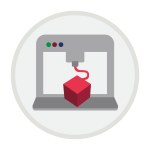
Additiv tillverkning, även känt som 3D-printing, är en viktig teknik för rymdtillämpningar. Du kan också använda den för ditt projekt.
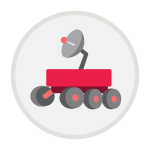
Rovers och robotar är avgörande för att människan ska kunna utforska rymden. Bli ingenjör och bygg din egen robot.
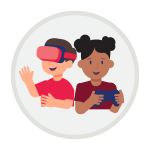
Skapa ett rymdhabitat i ditt favoritspel som Minecraft eller Roblox, eller ge det en extra dimension med verktyg för förstärkt och virtuell verklighet

Lär dig mer om rymdmiljön genom att utföra vetenskapliga experiment. Få inspiration från våra klassrumsaktiviteter.
Moon Camp Challenge är en plattform för att dela med sig av projekt som rör utforskning av rymden. Det kan handla om vetenskapliga experiment, konstnärliga projekt, teknisk design, en förstärkt verklighet och mycket mer. Men detta är bara exempel; du kan använda ditt kreativa sinne för att utforma ditt eget unika projekt inspirerat av den verkliga världen.
Ny teknik håller på att utvecklas för att stödja den framtida utforskningen av rymden. Bland annat 3D-utskrift med hjälp av månjordanaloger, uppblåsbara strukturer, temperaturreglerande material, växtforskning, fjärrstyrda robotar, dammreduceringsteknik, ny framdrivningsteknik, utforskning av den is som upptäckts vid månpolerna, vattenreningsutrustning, utvinning av vatten och metaller från regoliten och mycket mer. ....
Var kreativ och börja designa och skapa din egen Moon Camp nu!

Kombinera rymdforskning, konst och hantverk genom att bygga ett unikt Moon Camp-projekt. Lagen kan utforma sitt Moon Camp utan att behöva specialmaterial eller programvara, genom att använda material som är lättillgängligt för dem.
Ytterligare information: som utgångspunkt rekommenderar vi användning av klassrumsaktiviteten Skydd mot månen, för åldrarna 8 till 12 år.
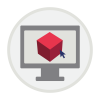
Om ditt team vill skapa en 3D-design och du är nybörjare föreslår vi att du använder Autodesk Tinkercad. Tinkercad är en gratis, lättanvänd webbaserad app för 3D-design som kan anpassas för alla åldrar. Följ oss dessa anvisningar för att anmäla dig.
Om du vill ta din 3D-designteknik till nästa nivå föreslår vi Autodesk Fusion 360. Fusion 360 är en kostnadsfri programvara för 3D-design för studenter, lärare och akademiska institutioner, som följer dessa anvisningar för att erhålla en kostnadsfri utbildningslicens.
Nedan hittar du exempel på 3D-design från team:
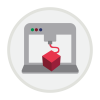
Idag kan vi 3D-printa nästan vad som helst, från verktyg och byggnader till celler och till och med mat. Men det är på jorden, där materialen är lättillgängliga. Hur är det i rymden eller på månen? Kan vi 3D-printa en månbas?
Ytterligare information: ESA:s ingenjör Advenit Makaya guidar oss genom processen med 3D-utskrifter för rymdtillämpningar i detta Video om att träffa experterna.
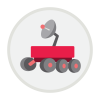
Inom en snar framtid förväntas besättningar bestående av astronauter och humanoida robotar arbeta tillsammans för att utnyttja rymden med hjälp av bioniska händer, robotarmar och autonoma rovers.
Dessa kommer att vara komplexa maskiner, med en robust konstruktion, som kan fungera under de tuffa förhållandena i rymden.
Ytterligare information: du kan använda klassrumsaktiviteten Bionisk hand, 8 till 12 år gamla, som utgångspunkt för att utveckla en enkel robotkomponent med hjälp av kartong och sugrör.
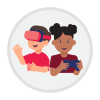
Skapa en rymdmiljö i din favoritspelsmiljö, t.ex. Minecraft, Roblox eller . Kerbal Space Program eller i en förstärkt eller virtuell värld. Skapa din design direkt i speluniversumet eller ladda upp dina egna 3D-objekt. Gå igenom din rymdbas med din astronautavatar eller ett headset och upplev hur det är att leva i rymden från en förstapersonsvy.
Bildkredit: Microsoft

Moon Camp-projektet erbjuder många förberedande klassrumsaktiviteter som fokuserar på "learning by design" och vetenskapliga experiment. När eleverna genomför dessa aktiviteter kommer de att lära sig ämnen från läroplanen samtidigt som de får veta mer om rymdmiljön.
Denna uppsättning resurser omfattar ämnen från läroplanerna för fysik, matematik, biologi, kemi, naturvetenskap, teknik, konst, databehandling, samhällskunskap och ekonomi. Dessa aktiviteter rekommenderas från 6 till 18 år.
För mer information och för att få tillgång till alla klassrumsaktiviteter, besök Resurser sida.